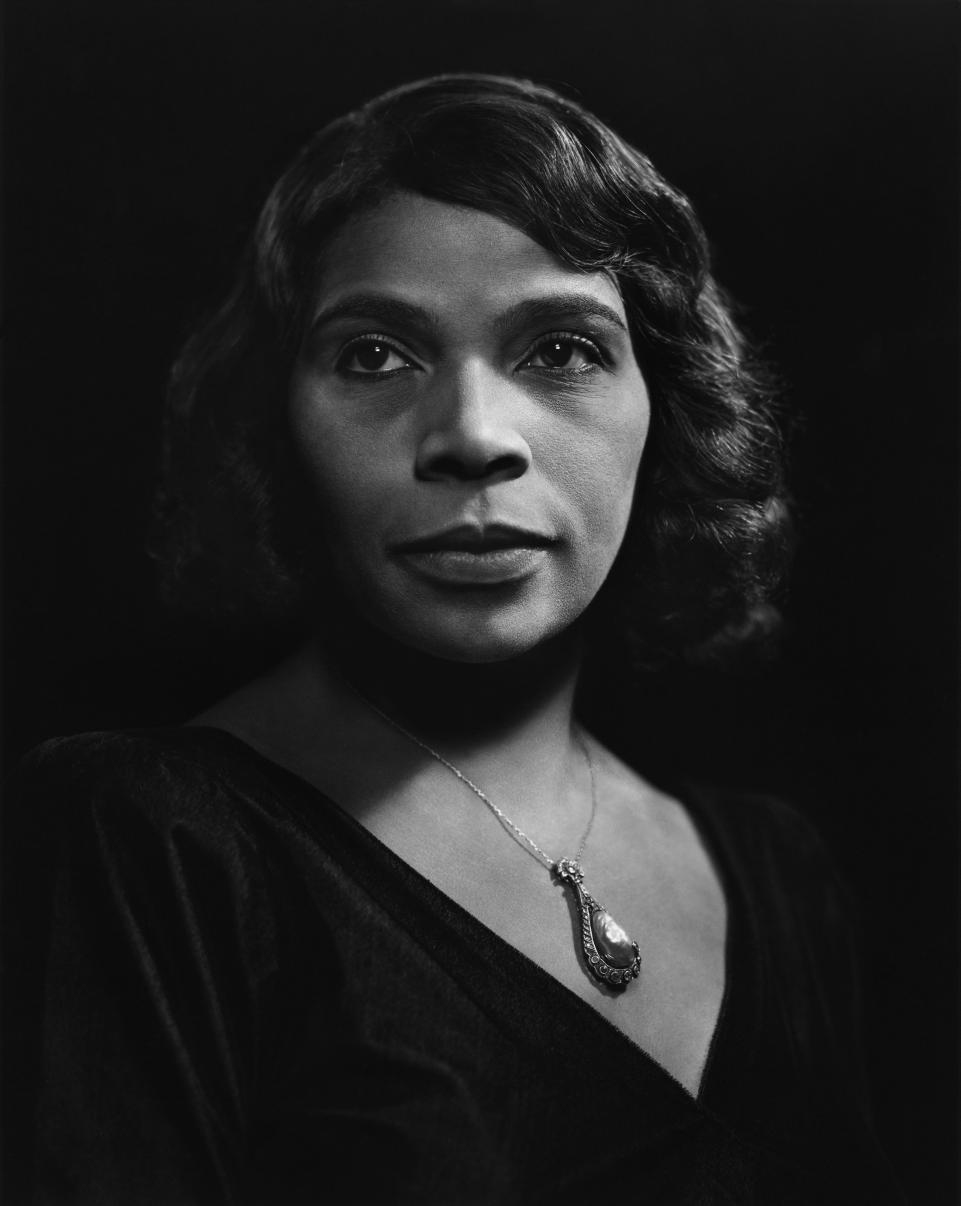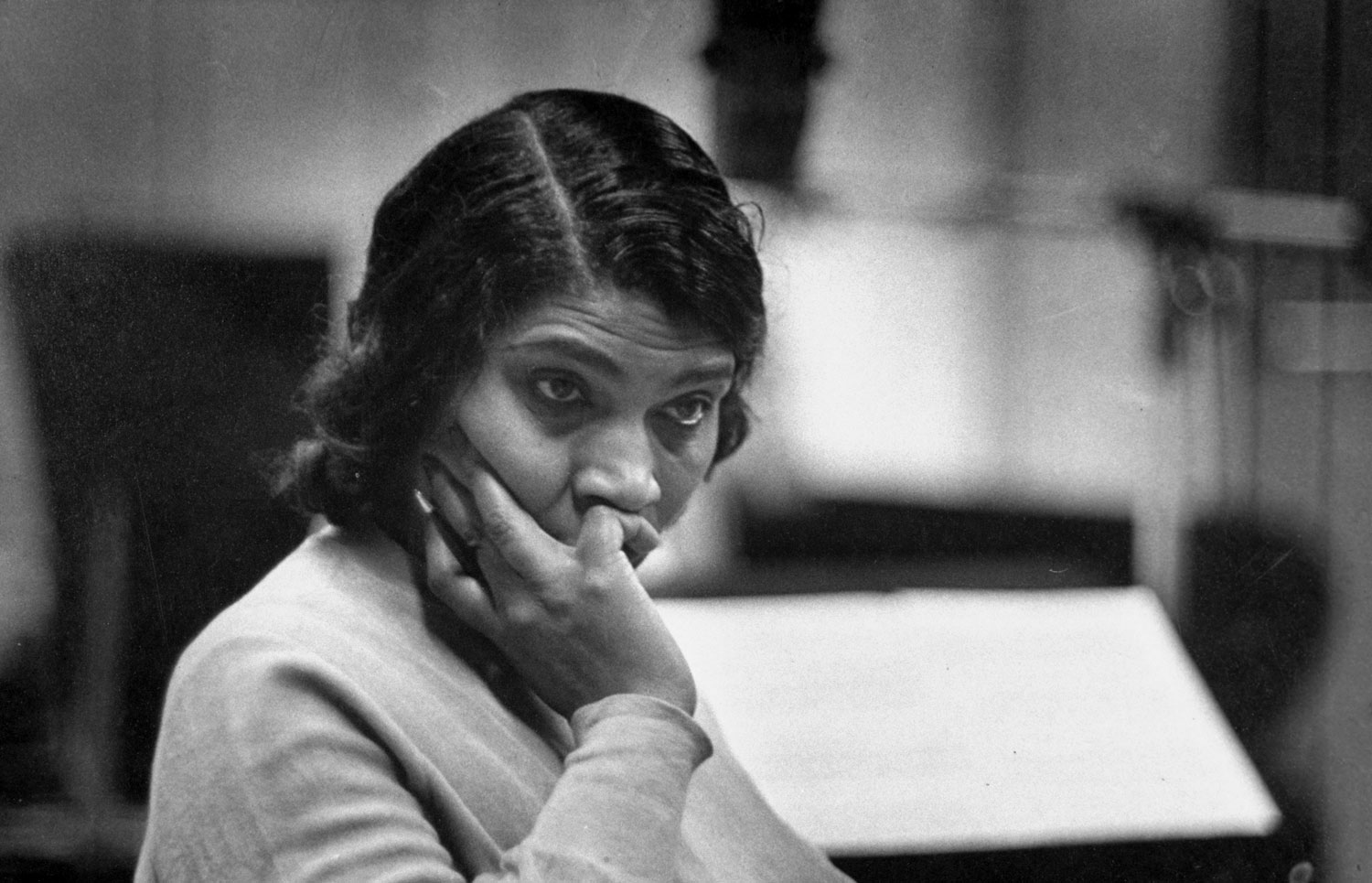by Anne Tedards
I would be fooling myself,” Marian Anderson once wrote, “to think that I was meant to be a fearless fighter; I was not meant to be a soprano instead of a contralto.” Nevertheless, in the spring of 1939, Anderson found herself in the middle of a raging battle.
Although racial bigotry has by no means disappeared from the United States, in the years before World War Il, it was even more overt and widespread than it is today. Anderson had often seen bigotry’s ugly face as she criss-crossed the country on concert tours.
She saw it when hotel clerks took one look at her and suddenly announced a lack of space-even when reservations had been made and confirmed. She felt it, as she once remarked, “in the cold breeze t hat blew from the persons who were waiting on me” in restaurants that did not ordinarily serve “colored.” She heard it when hotel managers, having grudgingly registered her, suggested that she take her meals in her room instead of in the hotel restaurant. She heard it when strangers addressed her white companions as “Miss” or “Mr.” and called her “Marian.”
hat blew from the persons who were waiting on me” in restaurants that did not ordinarily serve “colored.” She heard it when hotel managers, having grudgingly registered her, suggested that she take her meals in her room instead of in the hotel restaurant. She heard it when strangers addressed her white companions as “Miss” or “Mr.” and called her “Marian.”
In one southern city, the local concert manager tried to cancel Anderson’s recital when she discovered that the singer often took the hand of her White accompanist during her end-of-performance bow. “We won’t stand for that here,” said the manager. Backed by more enlightened local residents, Anderson sang anyway, taking Vehanen’s hand at the conclusion of the concert as usual–but she never returned to that city.
Then there were the countless train rides during which conductors, horrified to discover that a Black woman had paid for and was occupying a drawing-room compartment, had protected other passengers from the awful sight by insisting that her compartment door be kept firmly shut.
Early in Anderson’s career as a concert performer, she often sang in segregated halls and theaters, although she was never happy about it. She finally refused to sing in any theater that had, as she put it, ”an invisible line marking the Negro section from the white.” She lost a number of otherwise good engagements because of her position, but she stuck to it.
The most dramatic response came from first lady Eleanor Roosevelt, who protested Anderson’s exclusion from Constitution Hall by publicly announcing her resignation from the DAR…Conductor Leopold Stokowski joined opera stars Lawrence Tibbett, Kirsten Flagstad, and Geraldine Farrar in signing a telegram to the DAR; its ban on Anderson, they said, was “undemocratic and unAmerican.”
Most of the fans in southern cities who came backstage to see her were Blacks. In her autobiography, Anderson wryly recalled an exception, a White woman who came backstage but who stood apart from the rest of the crowd. When everyone else had left, she handed her program to Anderson. “Since I’m back here,” she said, “I’ll take an autograph.” As Anderson was signing the program, the woman said, “I still don’t understand why you didn’t sing (the humorous popular song) ‘Chattanooga Choo Choo.” Anderson kept right on writing.
Some people might have thought that the singer’s patience in the face of slights, insults, and outright hostility indicated a lack of courage. But anyone who suspected her of cowardice simply did not know her. A gentle woman who detested confrontations, she saw herself as an emissary, someone who might show racists that they were mistaken. “My mission,” she wrote, “is to leave behind me the kind of impression that will make it easier for those who follow.”
In her autobiography, she said she tried to show racists that ”their attitudes were not based on knowledge.” Perhaps, she said, ” if they discover that they are wrong about an individual they will begin to realize that their judgment of a group is equally fallacious (mistaken).
One very hot summer night in Jackson, Mississippi, Anderson sang for an audience of 4,000 enthusiastic people. At the end of the program, she performed several encores, including her customary sign-off, “Ave Maria,” but the audience remained in place, begging for more. She obliged with the old American song, “Carry Me Back to Ol’ Virginny,” which she asked the audience to join her in singing. The crowd raised its voice with, as Anderson described it, “wonderful eagerness and unanimity.”
But not everyone was pleased. Several people complained loudly about the “audacity” of a Black woman asking whites to join her in song. This time, however, the racists were in a minority. The following day, the Jackson newspaper published an editorial praising both the singer and her audience. “Sometimes,” said the paper, “the human soul rises above itself, above racial prejudices.” One of the biggest tests for that “human soul,” however, was yet to come.
Sol Hurok, said Anderson in her autobiography, “sought appearances for me in all the places where the best performers were expected and taken for granted.” In 1938 Hurok decided the time had come for a recital in the nation’s capital. Early in her career, Anderson had sung in schools and churches in Washington, but she had never given a major concert there.
There was only one place suitable for such an event: Constitution Hall, the city’s largest and most prestigious auditorium.
Westbrook Pegler, a widely syndicated, ultraconservative newspaper columnist, sneeringly suggested that the affair was a “publicity stunt” staged by a “hitherto obscure Negro singer.“
Constitution Hall was owned by the Daughters of the American Revolution (DAR), a patriotic society formed in 1890. DAR members, of whom there were many thousands, were required to have ancestors who served in the Revolutionary War. They were also required to be White.
In June 1938, Hurok wrote to the manager of Constitution Hall, asking that a date well in the future–April 9, 1939–be reserved for a concert by Marian Anderson. The reply came quickly: April 9 was already booked. Hurok then asked for any of several other dates, but the answer was the same; unfortunately, said the manager, the hall had no open dates.
There was obviously more here than met the eye. Hurok asked the celebrated Polish pianist, Ignacy Paderewski, to apply for the same dates. Mr. Paderewski, said the Constitution Hall management, was welcome on any of these days. Hurok’s suspicions were confirmed by the chairman of the Howard University concert program. The hall, said this official, had a clause in its rental policy that prohibited “the presentation of Negro artists.”
Outraged, Hurok informed the press about the situation. The story, which made front-page news nationwide, shocked Americans. The most dramatic response came from first lady Eleanor Roosevelt, who protested Anderson’s exclusion from Constitution Hall by publicly announcing her resignation from the DAR. Other notable members of the organization followed suit, and Americans of all races and from all walks of life raised their voices in support of Anderson.
The renowned violinist Jascha Heifetz, who had already committed himself to a February concert in the DAR auditorium, said, “I am ashamed to play at Constitution Hall.” Conductor Leopold Stokowski joined opera stars Lawrence Tibbett, Kirsten Flagstad, and Geraldine Farrar in signing a telegram to the DAR; its ban on Anderson, they said, was “undemocratic and unAmerican.” Time magazine ran an article headlined “Jim Crow Concert Hall,” and New York City Mayor Fiorello H. La Guardia sent the DAR a wire saying, “No hall is too good for Marian Anderson.”
Some people, of course, took the side of the DAR. Westbrook Pegler, a widely syndicated, ultraconservative newspaper columnist, sneeringly suggested that the affair was a “publicity stunt” staged by a “hitherto obscure Negro singer.” And the Washington, D.C., Board of Education turned down Hurok’s request to stage an Anderson concert at the city’s Central High School. The school board’s rejection set off a new wave of protest. Angry Anderson supporters formed the Marian Anderson Citizens Committee, which picketed the board’s offices and gathered 6,000 signatures on a statement denouncing its action. Students at all White Central High wrote an editorial for their school newspaper, calling for a reversal of the board’s decision. They wanted, they said, “the honor of playing host to one of the musical world’s greatest artists,” and to “prove to the rest of the world that this country holds no grudges because of race or color.” The protests failed to move the school board.
What were Marian Anderson’s personal feelings? “I was saddened and ashamed,” she said in her autobiography. “I was sorry for the people who had precipitated the affair…. They were not persecuting me personally or as a representative of my people so much as they were doing something that was neither sensible nor good.”
Reporters from all over the world besieged Anderson with questions:”What is your attitude about the DAR?” “Do you feel insulted by this refusal?” “What do you intend to do about it?” I did not want to talk, she said later, “and I particularly did not want to say anything about the DAR.” She knew that many DAR members disagreed with the organization’s official policy, and she held fast to her conviction”that a whole group should not be condemned because an individual or section of the group does a thing that is not right.”
The situation was resolved by action from an unlikely quarter: The United States government. On February 24, Secretary of the Interior Harold Ickes– probably at the instigation of Eleanor and Franklin Roosevelt–made Marian Anderson an unusual offer. He invited her to give a free public recital, open to all, on the steps of the Lincoln Memorial. The concert would be held on Easter Sunday, April 9, 1939.
At first, Anderson was hesitant about the plan. She felt unsuited for hand-to-hand combat,” she hated ” a lot of show,” and she was unsure about the outcome of such a gesture. “I studied my conscience,” she wrote. “As I thought further, I could see that significance as an individual was small in this affair. I had become, whether I liked it or not, a symbol representing my people.”
Anderson talked it over with her mother. “You know what your aspirations are, ” said Anna Anderson. “I think you should make your own decision.” Her mother, wrote the singer later, ” knew what the decision would be. I could not run away from this situation. If I had anything to offer, I would have to do so now.”
The concert was scheduled for 5:00 P.M. Early in the afternoon a crowd began to gather, and by concert time, a sea of humanity stretched from the Lincoln Memorial to the Washington Monument. A squad of motorcycle policemen escorted Anderson and Vehanen to the platform that had been built in front of the memorial.
Despite her years of experience, despite the innumerable concerts she had given, despite the fact that she had been called one of the century’s greatest singers by Arturo Toscanini, Anderson was terrified. ” My heart leaped wildly, and I could not talk,” she said in her autobiography. ” I even wondered whether I would be able to sing.”
Mustering all her professionalism, she displayed an outward calm. ” The arm which I took to steady her,” recalled Sol Hurok, “was steadier than my own.” She was introduced to the dignitaries who had assembled for the concert, although, as she said later, “If I did not consult contemporary reports I could not recall who was there.” Present were Supreme Court justices, senators, congressmen, diplomats, cabinet members, and other high government officials.
Students at all White Central High wrote an editorial for their school newspaper, calling for a reversal of the board’s decision. They wanted, they said, “the honor of playing host to one of the musical world’s greatest artists,”
Introducing Anderson, Interior Secretary Harold Ickes noted that the monument to Abraham Lincoln was a fitting place for this concert. “Today,” he said, ” we stand reverently and humbly at the base of this memorial to the Great Emancipator while glorious tribute is rendered his memory by a daughter of the race from which he struck the chains of slavery.”
Concluding his speech, Ickes said, “Genius, like justice, is blind…. Genius draws no color line. She has endowed Marian Anderson with such a voice as lifts any individual above his fellows, as is a matter of exultant pride to any race.”
Anderson stepped out from the memorial’s towering marble columns and looked at the expectant faces of 75,000 men, women, and children of all races. “I had a feeling that a great wave of good will poured out from these people, almost engulfing me,” she wrote later. She began to sing “The Star-Spangled Banner,” her voice soaring over and blending in with the voices of the multitude before her.
Anderson’s program included “America,” the aria “O Mio Fernando,” Schubert’s “Ave Maria,” and several spirituals. When she finished, a roar from the crowd exploded the stillness of the Washington evening. “I am overwhelmed,” she said. “I can’t tell you what you have done for me today. I thank you from the bottom of my heart again and again.”
At this point thousands of people rushed toward the stage, reaching out their hands to Anderson. Walter White, secretary of the NAACP, later recalled a little Black girl in the surging crowd. She was dressed in her best clothes for Easter and her face was streaming with tears. White said, “If Marian Anderson could do it, the girl’s eyes seemed to say, then I can, too.” The nation had joined, as historian William Manchester put it, “to give prewar America’s civil rights record one shining moment of glory.”
Not long after the Easter Sunday concert, the Department of the Interior commissioned a mural commemorating the event. Anderson was invited to Washington for its 1943 unveiling. At the ceremony, Secretary Ickes called Anderson “a symbol of the willing acceptance of the immortal truth that (in the words of Abraham Lincoln) ‘all men are created equal.”
Responding to the tribute, Anderson said, ” I am deeply touched that I can be in any way a symbol of democracy. Everyone [at the concert] was a living witness to the ideals of freedom for which President Lincoln died. When I sang that day, I was singing to the entire nation.”
Anderson had accepted an invitation to sing at a benefit concert after the unveiling. The invitation had come from the DAR, and the concert was held at Constitution hall.
Characteristically, the singer took no personal credit for the end of segregation at the Washington auditorium. “When I finally walked into Constitution Hall and sang form its stage, I had no feeling different to what I have in other halls,” she said. “There was no sense of triumph.” Noting that “the hall is now open to other performers of my group, she did admit, however, that there is no longer an issue, and that is good.”
Futher reading
Anderson, Marian. My Lord, What a Morning. New York, Viking, 1956.
Hurok,S., and Ruth Goode. Impresario: A Memoir. New York: Random House, 1946.
Truman Margaret. Women of Courage. New York: Morrow, 1976.

